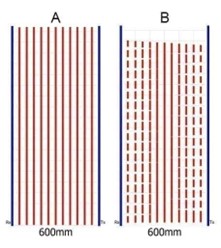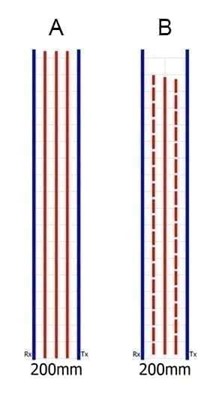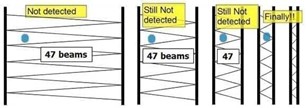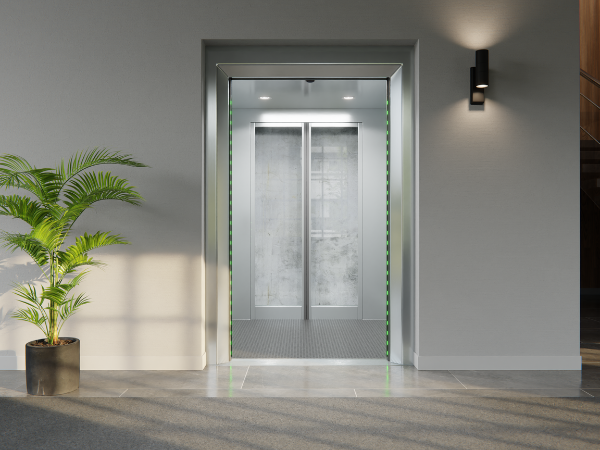Light curtains for lifts have been the established technology for protecting passengers from door impacts for many years. Some technologies can further enhance passenger safety and significantly reduce the risk of damage due to door strikes.
How do 2D and 3D light curtains increase lift door safety?
The majority of light curtains provide a two-dimensional detection zone. This means that detection is only possible once an object is between the elevator door edges. To improve on this, a suitable option would have a three-dimensional detection zone which can detect outward into the corridor. This provides earlier signals to lift doors on the approach of an object therefore increasing elevator safety and reducing potential impact on doors.
Some devices use an additional sensor to create the 3D detection which is often mounted in the transom, and this increases fitting time. Light curtains where the 3D detection is created by the light curtain itself without the need for a third sensor are the most convenient to fit. They also offer the added benefit of ensuring that the 3D projection is related to the door separation. As the doors come closer together, the 3D detection zone is reduced relative to the risk of door strike and usually disabled completely for the last 20cm or so of door closing.
3D detectors offer potential benefits in many installations but are particularly relevant in high-traffic public areas; where passengers may be running to catch the lift, queuing to enter the lift car or wheeling large objects such as trolleys.
What other safety options are available for door edges?
MEMCO by AVIRE has one a step further to supplement the protection offered by conventional elevator safety devices by installing coloured LED’s throughout the length of each light curtain. When installed dynamically (fitted to the car doors), these lights are visible as strips along the moving leading edge of each lift door. In normal operation, the LEDs flash green while the doors are opening, are solid green while the doors are wide open and flash red while the doors are closing.
The original intention of Panachrome+’s design was to enhance safety for the visually, or mobility impaired. The visibility of the lit door edge enhances elevator safety by making it easier for passengers to determine its status. The visual cues can also be enhanced with audible voice cues. “Talking doors” that warn of closing doors are powered by built-in devices called voice annunciators.
Visual and audible cues, combined with 3D detection, reduce the chances of door damage, which is critically important where slow, heavy, or large objects are frequently entering lift cars.
Examples include beds being pushed into hospital lifts, shopping carts in mall elevators, and baggage carts in airports or hotel lifts. In these circumstances obvious indications of door-edge movement give advance warnings of lift doors closing and may increase the time a passenger has to react and avoid an impact from closing elevator doors.
Which light curtain is the best for your needs?
When selecting a suitable light curtain for your lift door safety application it is important to consider several factors before making your decision. Diode count, number of beams and response time all play a part in determining the relative performance of a particular detector, and no feature should be judged in isolation.
Let’s look a little further into how each of these features work.
Diode count
The most important feature of a light curtain is the number of diodes it contains. This number is related to the smallest target that can be detected, particularly at the detector’s edges. The mor diodes, the better the coverage.
Number of beams
When implemented correctly, diagonal beams will improve detection capability for smaller objects. Using a criss-cross pattern with four or five scans per diode will easily provide detection of 12mm (a child’s finger) virtually anywhere between the detectors, except at the detector’s edges.
However, the stated number of beams is only available at wide separations and beams sometimes have such poor sensitivity that they are effectively redundant. Increasing beam counts further (three up and three down) will not improve performance. Beware: the number of beams can be used as a marketing ploy to demonstrate higher performance.
Scanning speed
Some light curtain manufacturers claim that offset diagonal beam systems and faster scanning provide performance benefits over rival technology. This is not actually the case.
Imagine two detectors that use the same diagonal scanning method, right up to when the doors close. Detector A has 32 diodes while Detector B features 24 diodes.
When the doors are approximately 600mm or more apart, detector A switches to an up-and-down two-beam pattern, giving four scans per diode. This dramatically increases the beam pattern density.
The 50mm target is used as the benchmark for detector testing. The scans below compare performance with a 50mm target for Detectors A and B. A continuous red line indicates complete detection, while a broken line shows areas where targets are missed. As can be seen, there are many gaps for Detector B, but none at all for Detector A.

Detector B is particularly weak when the doors are near to closing – it has very poor close-in sensitivity with a relatively large target.

The impact of these large gaps can indirectly extend the response time of the detector to several seconds. The doors will have to move quite a distance before an object, such as a hand, is detected. Detector B may scan very quickly, but that is pointless if it can’t detect a person’s hand for several seconds.

Response time
A detector’s response time is a secondary factor. It has never been considered important to reduce response time in either the design or specification stages, as it is not critical to the detector’s performance.
Lift doors travel at slow speeds to avoid physical damage to passengers or equipment. Detectors are mounted between the inner and outer doors. The depth of the doors (front to back) means that there are several centimetres of unguarded space.
Doors that close relatively quickly have a higher risk of hitting people or equipment (prams, wheelchairs, trolleys, etc.). A typical closing speed of a lift door is 0.5m/s. This means in 100ms the door will only travel 5cm until the detectors are triggered. The doors themselves have inertia, so they will continue to travel a short distance even after a trigger.
Detectors with improved scan or response times have very little perceived benefit to the end user. It is unlikely anyone would notice the door travel difference between a detector which can respond in 50ms and one which has a response time of 100ms.
MEMCO detector products typically scan at around 1.5ms per diode, plus some overhead at the end of the scan for processing. This means that a standard 32 diode detector will have a scan rate of approximately 70ms. This is a worst-case time though. As soon as any beam is obstructed, the hardware output is triggered within a few milliseconds. The average response time will therefore be much less, in the order of 40ms.
The Panachrome+ offers the added controller option which can be connected via CANBus for remote monitoring, offering an additional layer of safety and control.
Summary
As mentioned above, having light curtains means you will most likely have a compliant setup. However, given the many alternatives in the market of lift door edges, it is important to remember what each feature really means and how it works, to ensure you are investing in safety measures which will suit your requirements.
The main things to consider when deciding what technology to select for door edges for your lift setup are:
- The number of diodes is a detector’s most important feature. A 32-diode detector will detect smaller objects than a 24-diode model, and quicker.
- The number of beams in a pattern determines the smallest sized object which can be detected anywhere in the field.
- A detector’s response time is a secondary factor. Door closing speeds mean the difference between response times of 45ms and 70ms has a negligible effect.
To find out more about our market leading light curtain solution for optimal lift safety, please visit our Panachrome+ page.

